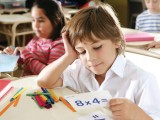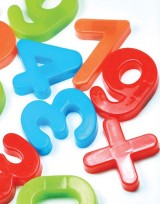Children need to develop fluency in maths, says Mike Askew, but this doesn’t mean a return to the dark days of ‘drill and practice’...
A tourist, lost in London, stopped a passer-by and asked ‘How do I get to the Royal Albert Hall?’ The passer-by, who happened to be a famous concert pianist, replied: ‘practice, practice, practice.’
Educational literature on mathematics rarely seems to discuss practice these days (although I’m sure it is still talked about in staffrooms). Searching the National Primary Strategy website for guidance on the role of practice failed to produce anything helpful. Are people frightened that by addressing the need to rehearse maths skills you are advocating a return to ‘drill-and-practice’ teaching?
It’s important for pupils to be fluent in aspects of mathematics, and judicious use of practice can help develop fluency and strategies. It’s not a case of practice or problem-solving, understanding or rapid recall, but practice and problem-solving, understanding and (appropriate) rapid recall.
Consider a calculating strategy like ‘bridging through a multiple of ten’. For example, to work out that 36 + 7 = 43 you might first add 4, making the 36 up to 40, and then the remaining 3. This is an effective and efficient strategy, but only if you are fluent in knowing what to add to a number to make it up to the next multiple of ten speedily and confidently being able to say 36, 4; 58, 2; 67, 3. If children have to use their fingers to count-on, the strategy is pointless; they might as well carry on counting-on in ones. So what sorts of practice helps develop such fluency?
 Practice activities need to be simple so that learners are focused on what they are practising rather than getting to grips with rules of complicated games or activities. Multiplication Max is quick to set up, easy to organise, and focused on the key fluency skills of knowing multiplication bonds and mentally adding twodigit numbers. It’s best done as a whole class activity; give the dice to pairs or small groups of children and there’s a chance they’ll start to focus on whose turn it is to roll the dice, or where it has fallen on the floor, and get distracted from focusing on practising multiplication.
Practice activities need to be simple so that learners are focused on what they are practising rather than getting to grips with rules of complicated games or activities. Multiplication Max is quick to set up, easy to organise, and focused on the key fluency skills of knowing multiplication bonds and mentally adding twodigit numbers. It’s best done as a whole class activity; give the dice to pairs or small groups of children and there’s a chance they’ll start to focus on whose turn it is to roll the dice, or where it has fallen on the floor, and get distracted from focusing on practising multiplication.
Multiplication Max
Everyone writes down six different numbers between 1 and 10. You roll a dice and announce the score. The children choose one of the numbers they wrote down to multiply with the number on the dice. They write the product down.
After six rolls of the dice, they figure out the total of their six scores. Who got the largest total? The game can be varied by rolling a 1 – 10 dice or playing to try and get the lowest score.
Games like Round the World are popular with children and teachers. One child stands behind another who is seated. They go head-to-head on a question posed by the teacher and the first to get it right moves on to stand behind the next person while the ‘loser’ sits down.
I’ve seen this or similar games played often, and they provoke a general buzz of excitement with many of the children wanting to offer hints and answers even when it’s not their turn. But most children only get to answer one question and, if you watch the class, there is often a substantial number of children who sit back while waiting for their turn and do not engage with the questions.
Practice activities need to keep everyone working on the maths for as much time as possible. One From Each is easily adapted to practice different types of calculation and gives individuals some control over the level of difficulty.
One From Each
Put two circles on the board and write five or six numbers in each. Suppose you want the children to practice finding the difference between pairs of two-digit numbers, then the circles might contain 25, 48, 63, 89, 91 and 17, 32, 56, 74, 90. Children choose a number from each circle and find the difference between them. Challenge them either to make up 15 different calculations, or to complete as many as they can within a time limit.
 Musicians practice playing scales daily, but not all day. Developing mathematical fluency is best done little and often rather than in less frequent, longer blocks of time. Set time limits and stick to them. If you say children have five minutes to work on ‘Finding 50’ then stop after that time. Better to challenge them to find more on a different day than to extend the time.
Musicians practice playing scales daily, but not all day. Developing mathematical fluency is best done little and often rather than in less frequent, longer blocks of time. Set time limits and stick to them. If you say children have five minutes to work on ‘Finding 50’ then stop after that time. Better to challenge them to find more on a different day than to extend the time.
Finding 50
| 15 | 22 | 17 |
| 18 | 25 | 20 |
| 8 | 15 | 10 |
Put this grid on the board. How many combinations of numbers can the children find that total to 50?
I’m not a fan of using league tables within class. While being top of the chart may encourage the high achievers, only one person can ever be at the summit, so how does that motivate those at the bottom? Ordered charts reinforce and make public the class mathematical pecking order. In contrast, tracking progress against your own performance can be motivating.
Time Trials
A simple resource for practice that I use a lot is a 10 x 5 grid of 50 numbers. I have two different versions:
1. The first has the numbers 1 – 10, each repeated five times and randomly distributed across the grid. I use this for practising
multiplication bonds.
2. The second has 50 two-digit numbers randomly arranged on the grid (a spreadsheet is a good way to create these). I usually fit two grids on a single side of an A4 sheet – both use the same numbers but they are arranged in different orders. This can be used for practising rounding, doubling, adding ten and so forth. The same operation is performed on every number in the grid with the answer being written down alongside each number. For example, using the grid of repeated 1 – 10s to practice multiplying by ten means writing down 10 alongside every 1, 20 alongside the 2s and so forth.
I get the children to fill as many of the boxes as they can within a strict time limit of three or five minutes. (Any child who manages to complete the grid within that time is told how long they took and they note this down.) A whole class might practice multiplying by 5. On another occasion, everyone might be doubling the twodigit numbers or some might be adding 9 to each while others are adding 29.
After they have checked their work, we discuss the different strategies that the children used. Who worked through one square at a time? Who filled in all the easy ones first? Who used the answers they knew quickly to help them figure out other answers? I tell the children that they will be filling in the grid again in a few days time and to practice at home to see if they can improve their performance – either by getting more right or beating their best time. This way everyone’s improvements (and everyone does improve) can be celebrated.
1) Be simple to set up and do
2) Be done little and often
3) Keep everyone focused on the maths
4) Help children see their progress
Mike Askew is Director of BEAM Education and Professor of Maths Education, King’s College, London. BEAM Education is a specialist publisher of mathematical resources, and provides training consultancy in mathematics education. They publish a range of more than 100 books, mathematical games and equipment. Visit http://www.beam.co.uk to find out more.
“Developing mathematical fluency is best done little and often rather than in less frequent, longer blocks of time”
Make World Book Day Extra Special This Year
Ace-English
Supporting parents with maths
Ace-Maths
